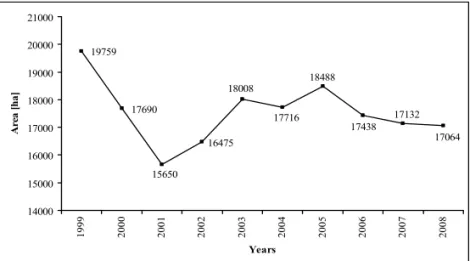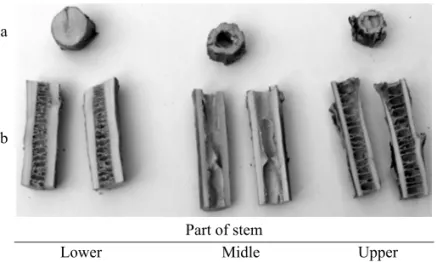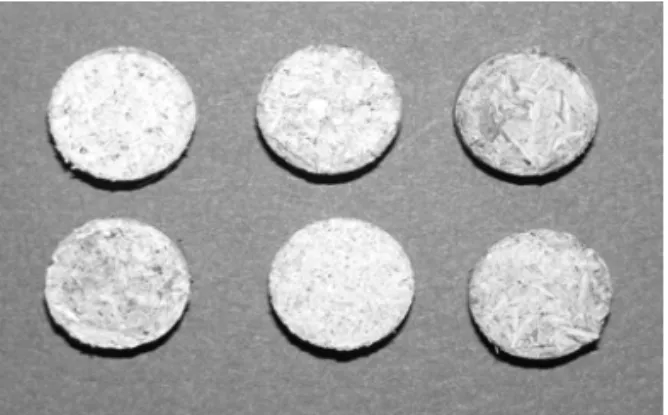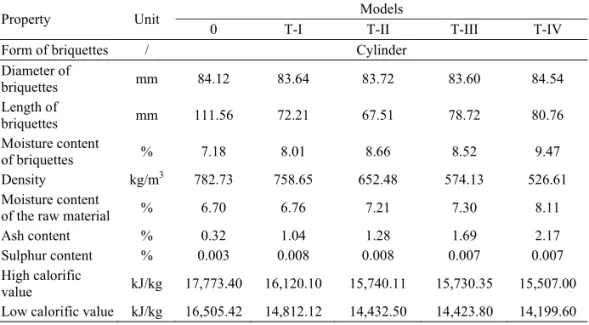POSSIBILITIES FOR UTILISATION OF TOBACCO STEMS FOR PRODUCTION OF ENERGETIC BRIQUETTES
Mile Đ. Peševski1*, Borče M. Iliev2, Dragić Lj. Živković3, Violeta T. Jakimovska Popovska2, Marija A. Srbinoska4
and Blaže K. Filiposki4
1
University of “Ss. Cyril and Methodius”, Faculty of Agricultural Sciences and Food, blvd. „Edvard Kardelj” b.b., 1000 Skopje, Macedonia
2
University of “Ss. Cyril and Methodius”, Faculty of Forestry, blvd. „Edvard Kardelj” b.b., 1000 Skopje, Macedonia
3
University of Belgrade, Faculty of Agriculture, Nemanjina 6, 11080 Belgrade-Zemun, Serbia
4
Scientific Tobacco Institute, Kičevski pat bb., 7500 Prilep, Macedonia
Abstract: Tobacco (Nicotiana tabacum L.) belongs to the group of plants that produce agricultural raw material. Besides leaves, which are used to satisfy the passion for smoking, tobacco can be used for producing oil and biodiesel, because it contains 30-40% of vegetable oil. Because of its content of citric acid, tobacco can be used for production of dyes and varnishes. Seed cake contains high percentage of proteins (35-44%) and can be used as livestock feed. Because of the high contents of lignin (40-45%) and cellulose (28-40%), tobacco stems can be used for production of energy briquettes, which makes tobacco obtain a new usability value. The aim of the experimental researches presented in this paper is to define the possibilities for production of briquettes from tobacco stems and wood raw material and to evaluate the impact of this kind of raw material on briquettes properties. For this purpose five models were made: O-control model: 100% wood raw material (BW); model T-I - 25% tobacco stems (TS) : 75% BW; model T-II - 50% TS : 50% BW; model T-III - 75% TS : 25% BW and model T-IV - 100% TS. The results of the research show that density of the briquettes is within the limits of 526.61 kg/m3 for model T-IV, to 782.73 kg/m3 for control model-O. The ash content is a little lower than the standard values and it ranges from 0.32% for O-control model, to 2.17% for model T-IV. The sulphur content is much below permissible content (0.08%), and it ranges from 0.003 to 0.008%. These briquettes, according to the low calorific value are classified in II and I class. In the smoke of the burned briquettes, minimal quantity (0.005%) of nicotine is identified.
Key words: tobacco, stem, lignocellulose, briquettes, kJ.
Introduction
As it is known, tobacco plant is cultivated mainly for its leaf, which besides for smoking, sniffing and mastication, is used because of its nicotine content. Nicotine is created in the root of tobacco plant, mainly from the most common form of nitrogen that is absorbed from the ground, and it is present everywhere in the plant, except in the seed (Hawks and Collins, 1994).The distribution of nicotine in tobacco differs from type to type. Bajlov and Popov (1965), e.g. reported that 0.417 of the total nicotine content in Basma (which is rapidly expanding in R. Macedonia) is represented in root, 0.278% in stem, 1.206% in leaf and 0.513% in flower. According to the same authors, the lower part of the stem contains 0.08%, the middle part 0.13% and the top 0.16% of the total content of nicotine.
The results of many investigations in the world and in our country confirm that tobacco plant has forms of use other than smoking. For example, it can be used in food industry because of its content (over 10%) of citric acid (Srbinoska, 2005). The pectines, carotinoides, enzyme pectinase, solanesol (Coenzyme Q10) etc. are separated from tobacco (Tso, 1977). It is interesting to mention that beside lignin, tobacco contains relatively high quantity of cellulose. According to Veselinov (1964), the highest cellulose content is found in tobacco stems (35-40% of dry matter). Uzunoski (1985) reported that the main rib of the leaf of someBulgarian tobacco varieties contains 10-15% of cellulose. Tobacco stems and middle leaf ribs can be used for production of paper and cardboard packaging (Agrupis and Maekawa, 1977; Hepworth and Vincent, 1998).
Dry tobacco stems are ligneous and middle leaf ribs are big and have a pulp structure. The cell walls of tobacco stem xylem contain 40-45% of lignin, which is in accordance with the quantity of lignin in the trees, with one difference - the density of tobacco stem is lower (Hepworth and Vincent, 1998). Today, tobacco stems and ribs are used as media for mushroom production. Tobacco residues (small parts, tobacco dust, ribs etc.) are used in production of reconstituted tobacco (Nuneski, 2000), and because of the relatively high content of K and N they can be used as a substitute for mineral fertilisers. Tobacco seed contains high percentage of oil (30-40%), which can be used in nutrition, in production of biodiesel fuel (Filiposki et al., 2008), as well as in manufacture of dyes and varnishes because of its content of linoleum oils (Srbinoska, 2005). The seed cake obtained after extraction of oil from tobacco seed can be used as additional animal feedbecause of its high protein content (Filiposki et al., 2008).
It should be mentioned that there are still unsolved issues of economic and technological character, connected with collecting, transporting and storing of raw material, as well as with the selection of an adequate technological process.
Quantity of lignocellulose wastes from tobacco stems in R. Macedonia
Evaluation of the quantities of lignocellulose agricultural wastes in a form of tobacco stems is based on data of the State Statistical Office of R. Macedonia for a period of ten years (1999-2008), (Državen zavod za statistika na RM, 2007). In the first year of the investigated period tobacco area was 19,759 ha, after two years it decreased to 15,650 ha and in 2003 it was about 18,000 ha. After that, it has been stabilized to over 17,000 ha. The average tobacco area is 17,500 ha (Figure 1).
16475 17690 19759 17064 17132 17438 18488 17716 18008 15650 14000 15000 16000 17000 18000 19000 20000 21000 1 999 2 000 2 001 2 002 2 003 2 004 2 005 2 006 2 007 2 008 Years Ar ea [h a ]
Figure 1. Dynamics of tobacco area in R. Macedonia.
Estimation of the quantity of waste (tobacco stems) was made on the basis of the average number of plants of tobacco types Prilep-135,000 ha, Yaka-155,000 ha (Uzunoski, 1985) and 100 g dry mass/plant (Nuneski, 2000). Taking into consideration that, in fact, only 80% can be collected mechanically, then the total lignocellulose mass from tobacco stems in R. Macedonia is about 17,280 t per year.
Materials and Methods
The selection and preparation of stems were made at the Faculty of Forestry in Skopje, Department of composite materials. Dirt and impurities of the stems were removed and they were cut into pieces of 10 cm length in laboratory conditions (Figure 2). The stems were dried to equilibrium humidity of about 10% in laboratory conditions.
a
b
Part of stem
Lower Midle Upper
Figure 2. Cross section (a) and longitudinal section (b) of tobacco stem.
Processing of tobacco stems into raw material for production of briquettes was made in two stages: I chipping in standard cylinder chipper, and II milling in hummer mill. The chipping is made together with the core part. In such a way, the technology for production of briquettes is rationalised (absence of equipment for removing of core part), so that a complete and rational utilisation of raw material is achieved (Figure 3).
a b Figure 3. Chipped raw material for production of briquettes.
For production of briquettes (experimental models), chipped beech wood waste material was used (Figure 3). Chipping and milling of the beech wood was made in the same way as for tobacco stems.
The fraction analysis of raw material was made on standard device, with five sieves of opening sizes 4.0×4.0; 2.5×2.5; 1.6×1.6; 1.0×1.0 and 0.5×0.5 mm. The fraction analysis was made on 100 g test specimen for 5 minutes, with oscillation amplitude of the 0.5 mm sieve opening and 250 r/min. Fractions from each sieve were weighed on an electronic balance with a precision of 0.01 g.
The experimental models were made by mixing the raw material from tobacco stems (TS) and wood raw material (WRM) without adhesive. The following models of briquettes were made: control model (0 model) - 100% WRM; model T-I-25% TS: 75% WRM; model T-II - 50% TS : 50% WRM; model T-III - 75% TS : 25% WRM and model T-IV - 100% TS. The briquettes were made in hydraulic press with specific pressure of 200 bar (20 MN/m2).
Testing of briquettes was made in accordance with the national standard MKS D.B9.021/87 (Institut za standardizacija na RM, 2002) and included the following properties: form and dimensions, density, moisture content, ash content, sulphur content and low calorific value.
The ash and free sulphur contents, as well as moisture content of the raw material were estimated after flaming the briquettes, during the testing of their calorific value. The ash content was estimated according to MKS B.Н8.3120 standard, in accordance with ISO 1171, the sulphur content was estimated according to MKS B.Н8.316, in accordance with ISO/DR 241. The high calorific value (low calorific valuehas already been calculated) was estimated according to MKS B.Н8.318 standard, in accordance with ISO/R 1928. For estimation of calorific value, free sulphur, ash content and moisture of the raw material, special briquettes in a form of tablets with a mass of 1 g were used (Figure 4).
Results and Discussion
The results of the laboratory investigations of fraction composition of chipped raw material and the properties of various models of briquettes are shown in Tables 1 and 2. Data for the particular properties are given as mean arithmetical values.
The analysis of fraction composition (Table 1) shows that minimum content of chipped raw material from the two components is found in the fraction of 4 mm (1.36%). The highest percentage of wood raw material is reported in fraction 0.5 mm, while of tobacco stems in fraction 1.6 mm. According to literature data, the best technological fraction for production of briquettes from chipped wood ranges from 0.5 to 7.0 mm. According to the same author, the raw material used for briquettes production is with a very fine agglomeration in a form of dust, up to 10 mm fraction size of the base sieve. The fraction composition of wood material and tobacco stems is in accordance with the limits defined in the literature. It can be objected only to the percentage participation of the finest fraction below 0.5 mm, which has no essential influence on briquette properties.
Table 1. Fractions of chipped raw material.
Type of raw material
Dimension: length/width (mm)
4.0 2.5 1.6 1.0 0.5 0 Participation (%)
Wood 2.40 6.35 14.72 22.66 38.09 15.78
Tobacco stems 1.36 15.92 57.63 4.86 10.45 9.78
Moisture content of the briquettes is tested according to thermo-gravimetric method, i.e. by drying the briquettes to constant mass (moisture content 0%). Values for the moisture content satisfy the requirements of MKS D.B9.021/87 standard, because the maximum moisture content for all models is 9.47% (Table 2). According to this standard, the permissible moisture content is 18%.
Table 2. Values of the characteristic properties of briquettes.
Property Unit Models
0 T-I T-II T-III T-IV
Form of briquettes / Cylinder
Diameter of
briquettes mm 84.12 83.64 83.72 83.60 84.54
Length of
briquettes mm 111.56 72.21 67.51 78.72 80.76
Moisture content
of briquettes % 7.18 8.01 8.66 8.52 9.47
Density kg/m3 782.73 758.65 652.48 574.13 526.61 Moisture content
of the raw material % 6.70 6.76 7.21 7.30 8.11
Ash content % 0.32 1.04 1.28 1.69 2.17
Sulphur content % 0.003 0.008 0.008 0.007 0.007 High calorific
value kJ/kg 17,773.40 16,120.10 15,740.11 15,730.35 15,507.00 Low calorific value kJ/kg 16,505.42 14,812.12 14,432.50 14,423.80 14,199.60
The quantity of ash components in briquettes afterflaming increases with the increase of participation of tobacco stems in the structure of the briquettes. According to the literature data, the quantity of ash components in briquettes made from wood raw material ranges from 0.2 to 0.42% (Josifov, 2005), indicating that ash content of the control model is within the permissible limits. Compared with the control model, other models have higher values, due to the chemical composition of tobacco stems. The ash content in models T-I and T-II is in compliance with Austrian (ÖNORM M 7135), Swedish (SS 18 71 20) and German (DIN 51731) standards for this property. The ash contents of Models T-III and T-IV exceed the recommended norm, but according to PFI (American Pellet Fuels Institute), their values are within the limits (<3%) of these standards.
The content of free sulphur in briquettes is very low, practically in traces (less than 0.008% belong to dry matter). A slow increase of ash content appears as a result of the increased participation of tobacco stems in briquettes structure from 25 to 50%, but then it is relatively decreased and stabilised at 0.007%, despite the fact that participation of tobacco stems in briquettes is 100%. Even so, these values are below the recommended limits according to the Austrian, Swedish and German standards (≤0.008%).
standards. Thus, the low calorific value of the briquettes should be ≥18,000 kJ/kg according to the Austrian standard, ≥16,900 kJ/kg according to the Swedish, and 17,500-19,500 kJ/kg according to the German standard. As a result of these values, as well as the values of ash and sulphur contents, it can be assumed that tobacco stems are prospective substitute for the basic wood raw material for the production of briquettes in the Republic of Macedonia.
Analyses of the nicotine content in dried tobacco stem of the type Prilep, variety P-80 and in the smoke during combustion of briquettes T-II were made in the Chemical laboratory of Tobacco Institute-Prilep. The same material was also used to estimate the total cellulose content. The nicotine content was determined by the method of Kurschner-Scharrer. The results show that cellulose content is 28.19% in the stem and 38.97% in briquettes. The presence of nicotine in dried stem is 0.53% and in the smoke it is minimal (0.005%), which means that usage of energy briquettes is ecologically acceptable, too.
Conclusion
Based on investigations, the following major conclusions and recommendations can be stated:
The lignocellulose matter in tobacco stems has comparatively low density (260 to 350 kg/m3) and with its anatomical structure and chemical composition it is similar to wood matter of the hardwood broadleaf species. These data define tobacco stems as suitable raw material for the production of briquettes.
It was estimated that from the total resource of tobacco biomass (an average of 25,000 t for the investigated period), only 80% (17,280 t) can be really used as raw material for the production of briquettes.
The utilisation does not make difficulties, except for the necessities of storage and preservation areas for seasonal collecting. The loss of mass during storage in chipped condition (in a form of chips) should not be higher than 10%. This should be a motive for organized approach in collection, transport and storage of tobacco stems for the needs of briquette production technologies.
Tobacco stem applied as lignocellulose material is appropriate raw material for production of different kinds of briquettes. In Pelagonia region and in south-eastern part of R. Macedonia relatively big quantities of tobacco stems are concentrated (over 87%). According to this, it can be said that their utilisation as the raw material for production of briquettes is beneficial, but for higher economic effects it is recommended to use T-I model, which guarantees production of briquettes with higher energy value.
The energy briquettes are ecologically acceptable because of the small presence of nicotine (0.005%) in the smoke during combustion of briquettes.
The good properties of the briquettes made from tobacco stems and wood, as well as the relatively low price of the raw material (practically without market value), determine the competitive capability of these briquettes for different fields of application.
Acknowledgements
The research presented in this paper is a part of the scientific research project No. 17-2045/4-05, financed by the Ministry of Education and Science, the Republic of Macedonia.
References
Agrupis, S.C., Maekawa, E. (1977): Industrial utilization of tobacco stalks (I). Physicochemical evaluation for biomass resources. CORESTA Proceedings: Group of smoke and technology. Hamburg, September, 7-11, pp. 237-244.
Bajlov, D., Popov, M. (1965): Proizvodstvo i prvična obrabotka na tjutjuna. Zemizdat, Sofija, pp. 138-139. Državen zavod za statistika na RM (2007): Popis na zemjodelstvoto, (2007). Kniga III, Skopje, 43 pp. Državen zavod za statistika na RM (2009): Statistički godišnik na RM. za 1999 do 2008, Skopje. Filiposki, K., Peševski, M., Filiposki, B. (2008): Tobacco in the 21 century. Međunarodni naučni
skup “Multifunkcionalna poljoprivreda i ruralni razvoj (III)”, Beograd, Tematski zbornik I, pp. 111-116.
Hawks, N.S., Collins, W.K. (1994): Načela proizvodnje virdžinijskog (flue-cured) duhana. Zagreb, 24 pp.
Hepworth, D.G., Vincent, J.F.V. (1998): Modeling the mechanician properties of xylem tissue from tobacco plants (Nicotiana tabacum ‘Samsun’) by concidering the importance of molecular and micromechanisms. Anal. Botany 81:761-770.
Institut za standardizacija na RM (2002): Makedonski standardi, Skopje.
Josifov, N. (2005): Briketi i peleti ot rastitelna biomasa. Universitetsko izdatelstvo “Sv. Kliment Ohridski”, Sofija.
Nuneski, I. (2000): Tehnoloski svojstva na tutunskoto folio proizvedeno vo svetot, so poseben osvrt na folioto od firmata “COMAS”. Tutun/Tobacco 50(11-12):270-287.
Srbinoska, M. (2005): Separacija, karakterizacija i aplikacija na aktivni komponenti od Nicotiana tabaccum L. so primena na konvencionalni i nekonvencionalni metodi. Doktorska disertacija. Tehnolosko-metalurski Fakultet, Skopje.
Tso, T.C. (1977): Tobacco as potential food source and smoke material. Beitr. Tabakforsch. 9(2):63-71. Uzunoski, M. (1985): Proizvodstvo na tutun. Stopanski vesnik, Skopje, 543 pp.
Veselinov, M. (1964): Stokoznanie na tjutjuna. DI “Tehnika”, Sofija, 111 pp.
MOGUĆNOSTI KORIŠĆENJA DUVANSKIH STABALA ZA PROIZVODNJU ENERGETSKIH BRIKETA
Mile Đ. Peševski1*, Borče M. Iliev2, Dragić Lj. Živković3, Violeta T. Jakimovska Popovska2, Marija A. Srbinoska4 i
Blaže K. Filiposki4
1
Univerzitet „Sv. Kiril i Metodij”, Fakultet za zemjodelski nauki i hrana, bul. „Edvard Kardelj” b.b., 1000 Skopje, Makedonija
2
Univerzitet „Sv. Kiril i Metodij”, Šumarski fakultet, bul. „Edvard Kardelj” b.b., 1000 Skopje, Makedonija
3
Univerzitet u Beogradu, Poljoprivredni fakultet, Nemanjina 6, 11080 Beograd-Zemun, Srbija
4
Naučni institut za duvan, Kičevski pat b.b., 7500 Prilep, Makedonija
R e z i m e
Duvan (Nicotiana tabacum L.) pripada grupi biljaka koje proizvode takozvanu drugostepenu poljoprivrednu sirovinu. Od duvana osim lišća, koje se koristi radi zadovoljavanja strasti pušača, može da se koristi i njegovo seme za dobijanje ulja i biodizela, jer ono sadrži 30-40% biljnog ulja, a zbog toga što sadrži i limunsku kiselinu ono može da se koristi i za proizvodnju boja i lakova. Semenska pogača, zbog visokog sadržaja proteina (35-44%) može se koristiti i za stočnu hranu. Radi visokog sadražja lignina (40-45%) i celuloze (28-40%) duvansko stablo može se koristiti i za proizvodnju energetskih briketa čime se daje nova upotrebna vrednost duvana. Cilj eksperimentalnih istraživanja je da se definišu mogućnosti proizvodnje briketa od duvanskih stabala i drvne sirovine i da se prouči nihov uticaj na svojstava briketa. Za ostvarenje tog cilja urađena su 5 modela: O-kontrola: 100% drvne sirovine (BW); model T-I - 25% duvanska stabla (TS) : 75% BW; model T-II - 50%TS : 50%BW; model T-III - 75% TS : 25% BW i model T-IV - 100% TS. Rezultati istraživanja pokazali su da se zapreminska masa briketa kreće od 526,61 kg/m3 kod T-IV do 782,73 kg/m3 kod O-kontrola sa 200 bari (20 MN/m2) specifičnog pritiska pri briketiranju. Sadržaj pepela je iznad standarda i kreće se od 0,32% kod O-kontrola do 2,17% kod T-IV. Sumpor je mnogo ispod dozvoljenog sadržaja (0,08%), a kreće se u granicama od 0,003 do 0,008%. Ove brikete, prema vrednosti donje toplotne moći se rangiraju u II i I klasu. U dimu pri sagorevanju briketa utvrđena je minimalna (0,005%) količina nikotina.
Ključne reči: duvan, stablo, lignoceluloza, brikete, kJ.
Primljeno: 22. januara 2010. Odobreno: 29. aprila 2010.




